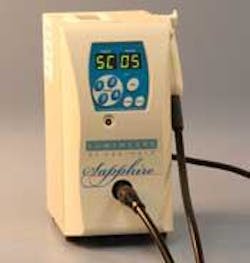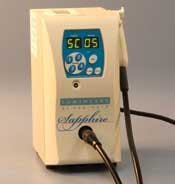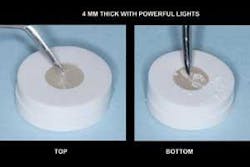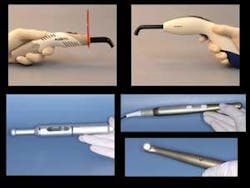Ask Dr. Christensen
by Gordon J. Christensen, DDS, MSD, PhD
In this monthly feature, Dr. Gordon Christensen addresses the most frequently asked questions from Dental Economics® readers. If you would like to submit a question to Dr. Christensen, please send an e–mail to [email protected].
For more on this topic, go to www.dentaleconomics.com and search using the following key words: curing lights, resin restorations, tooth sensitivity, high intensity plasma arc lights, halogen lights, LED lights, Dr. Gordon Christensen.
Q My curing lights are a few years old. I don't know if they are halogen or LED. They are now taking longer to cure resin than they did when they were new. I have to cure for about 30 seconds for typical restorations. Are there faster types of curing lights that are acceptable, or should I try to repair or upgrade my old curing lights?A About 10 years ago, there was a trend toward curing restorative resin with low–light intensity and then setting the light to cure with higher intensity. This curing method was called various names, including “ramp curing” and “phase curing.” There was significant controversy and disagreement on the subject, and dentists were curing anywhere from 3 seconds to 45 seconds with low, medium, and high intensity lights. Most of the lights were halogen, and a few were high intensity plasma arc lights (see Fig. 1).Subsequently, numerous low intensity, narrow wave length, light–emitting diode (LED) lights came on the market. Some dentists were beginning a curing cycle about 200 miliwatts per centimeter square for a brief interval and gradually increasing the power up to 600 mw/cm2 or higher power. This method of curing was thought to decrease alleged damage to both resin restorative material and the surrounding tooth structure. Some scientific papers showed a slight statistically significant reduction in shrinkage caused by this curing method when compared to high power fast curing. However, other research projects did not show clinically significant differences in restorations using fast light curing (high intensity) when compared to slower light curing (low intensity). Fortunately, the confusion lasted only a few years, and now most researchers and knowledgeable clinicians are recommending faster (high intensity) curing of resin restorative materials. There are still some researchers who prefer lower intensity light curing, but most clinicians favor high–intensity lights.
I have been using fast curing lights for nearly 10 years, based on our positive in–house research in Clinical Research Associates (now named CLINICIANS REPORT). We have observed both the similarity and clinical acceptability of resins placed using fast and slow curing in clinical practice, and in long–term research projects. Are there any reasons to continue curing resins with slow (low intensity) lights? From a long–term clinical standpoint, and with significant clinical observation over 10 years, high intensity curing lights are now considered to be acceptable.
However, there is one highly significant challenge with fast curing — heat! When curing with a high intensity curing light, a significant amount of heat is generated. That heat is transferred directly through the tooth structure to the pulp. Heat can cause immediate or delayed tooth sensitivity and even pulpal death.
The best way to overcome the heat produced by fast curing lights is to blow air from an air syringe on the tooth being restored at the same time the resin is being cured. According to research, the air cools the tooth and negates the heat production from the high intensity light.
I suggest the following simple heat test for dentists and dental staff persons who are changing to faster curing. Place the tip of the light guide of the curing light on your small fingernail, turn the light on, and hold the light on your fingernail until the heat is no longer tolerable. The heat soon builds up and in about three seconds, you will remove the light from your finger because of the discomfort. After accomplishing that simple test, use the same logic when curing resin in teeth.
Cure for about 3 seconds while cooling with air stream as mentioned previously. When using one of the high intensity curing lights, you can cure shade A2 restorative resin about 2 mm deep in three seconds (see Fig. 2). Of course, the following suggestions must be considered when curing:
- Darker color resins require more curing time.
- Curing thin layers of restorative resin or bonding agents requires less time than a standard cure.
- Microfills require more curing time than microhybrids, nanohybrids, or nanofills.
- Curing through ceramic requires more curing time.
- The farther the light is away from the resin being cured, the longer the curing takes.
- Small flecks of cured resin or bonding agent stuck on your curing tip greatly reduce the intensity of your light, thus increasing the amount of time needed to cure. You may easily remove this debris with a sharp scalpel and then polish the end of the curing tip with composite polishing discs. After the tip has been cleaned and polished, I suggest placing a two–inch square piece of household Saran wrap on the tip of the light. Replacing the wrap after each patient will help avoid accumulating another layer of debris on the tip.
I suggest that you change to using higher intensity curing lights. There are several excellent ones on the market (see Fig. 3). Some examples of three–to–five second curing lights are:
- bluephase 20i LED Light from Ivoclar Vivadent
- Demi™ LED Light Curing System from Kerr
- Elipar™ S10 LED Curing Light from 3M ESPE
- FUSION Curing Light from DentLight Inc.
- VALO LED Curing Light from Ultradent Products
High–intensity curing lights offer several advantages over lower–intensity lights. Two of the most important advantages for most dentists are time savings and a reduction in frustration.
Time use — Although the difference between a three–to–five second cure and a 30–second cure does not seem to be significant when considered in the context of a busy practice, there is a major time savings when using the faster high–intensity curing lights.
The following comparison emphasizes the savings between different lights. For example, assume:
- The dentist practices about 220 days per year
- He or she places about 10 resin–based composite restorations each day, thus placing about 2,200 restorations in a year
- Each restoration requires at least four cures, and some have six cures
- There will be 8,800 cures in one year
- 8,800 cures x 30 seconds = 264,000 seconds = 4,400 minutes or 73.33 hours
- 73.33 hours x $400 per hour = $29,332
Using the same assumptions, replace the low–intensity light from the previous equation with. a high intensity light and the time used for curing equates to about $2,933.
The difference in savings is significant. High–intensity lights save about $26,399 per year in a typical general practice. This is not pocket change.
When considering the ease of use, lack of frustration, and simplification of clinical procedures, high–intensity lights offer far more than just time and money savings.
In summary, high intensity curing lights are safe, easy to use, proven with research and clinical use, and highly preferred by clinicians who have experience with them. Get a new high–intensity LED or a plasma arc light. I suggest you not waste effort by upgrading your older lights.
Many techniques can benefit from the use of high–intensity lights. Among them are composite restorative procedures, flowable composite placement, cementation with resin cements, liners, resin–modified, glass–ionomer restorative material placement, sealants, and many more procedures. Do yourself a favor and cure resin faster and easier with high–intensity lights, while still retaining the quality of cure.
One of our newest videos shows me performing the numerous steps in oral rehabilitation in close–up live HD TV. Light curing is used in several aspects of this rehabilitation video. The one–hour video, V1934, is titled “Complex Oral Rehabilitation.” For more information, visit us online at www.pccdental.com or contact us by phone at (800) 223–6569.
Dr. Christensen is a practicing prosthodontist in Provo, Utah, and dean of the Scottsdale Center for Dentistry. He is the founder and director of Practical Clinical Courses, an international continuing–education organization initiated in 1981 for dental professionals. Dr. Christensen is a cofounder (with his wife, Rella) and senior consultant of CLINICIANS REPORT (formerly Clinical Research Associates), which since 1976 has conducted research in all areas of dentistry.



